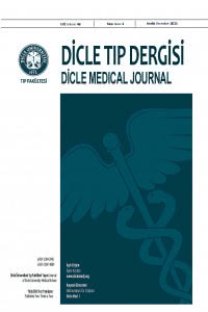Cellular functions of p53 and p53 gene family members p63 and p73
p53, p63, p73, hücre döngüsü, gen ailesi
Cellular functions of p53 and p53 gene family members p63 and p73
p53, p63, p73, cell cycle, gene family,
___
- Lane DP, Crawford LV. T antigen is bound to a host protein in SV40 transformed cells, Nature 1979; 278(2): 261-263.
- Varley JM, Evans DGR, Birch JM. Li-Fraumeni syndrome-a molecular and clinical review, Brit J Cancer 1997; 76(1):1- 14.
- Velculescu VE, El-Deiry WS. Biological and clinical impor- tance of the p53 tumor suppressor gene. Clin Chem 1996; 42 (6): 858-68.
- Prives C, Manfredi JJ. The p53 tumor suppressor protein: meeting review. Genes Dev 1993; 7(4): 529-34.
- Haris CC. Structure and function of the p53 tumor suppressor gene: clues for rational cancer therapeutic strategies. J Nat Can Inst 1996; 88(20): 1442-55.
- Lin YL, Sengupta S, Gurdziel K, Bell GW, Jacks T, Flores ER. p63 and p73 transcriptionally regulate genes involved in DNA repair. PLos Genet 2009; 5(10):e1000680.
- Lee HP. Tumor suppressor genes: a new era for molecular ge- netic studies of cancer. Breast Cancer Res Treatment 1991; 19(1): 3-13.
- Mills AA, Zheng BH, Wang XJ, Vogel H, Roop DR, Bradley A. p63 is a p53 homologue required for limb and epidermal morphogenesis. Nature 1999; 398(4):708-13.
- Moll UM, Slade N. p63 and p73: Roles in development and tumor formation, Mol Cancer Res 2004; 2(7): 371-86.
- Kaelin WG. The p53 gene family. Oncogene 1999; 18(11):7701-5.
- http://www.ncbi.nlm.nih.gov/protein/11066970?from=1&t o=393&report=gpwithparts (09.02.2011).
- Gabriel JA. The Biology of Cancer, (Second Ed.), John Wi- ley and Sons Ltd, West Sussex, England, 2007:37-40.
- Bunz F. Requirement for p53 and p21 to sustain G2 arrest after DNA damage. Science 1998; 282:1497-501.
- Schulz WA. Molecular biology human cancers an advanced student’s textbook, Springer, Dordrecht, Netherlands 2007: 101-109.
- Tan Y, Luo R. Structural and functional implications of p53 missens cancer mutations. PMC Biophysics 2009; 2(5): 1-10.
- Meek DW. Tumour suppression by p53: a role for the DNA damage response? Nature 2009; 9(4):714-23.
- Gasco M, Shami S, Crook T. The p53 pathway in breast cancer. Breast Cancer Res 2002; 4(1):70-6.
- Ho CW, Fitzgerald MX, Marmorstein R. Structure of the p53 core domain dimer bound to DNA. J Biological Chem 2006; 281(42): 20494-502.
- Devlin TM, Text Book of Biochemistry with clinical corre- lations, 6th ed., Wiley-Liss., Hoboken, NJ, USA 2006:185.
- Yamaguchi Y. Watanabe H, Yirdiran S, et al. Detection of mutations of p53 tumor suppressor gene in pancreatic juice and its application to diagnosis of patients with pancreatic cancer: comparison with K-ras mutation. Clin Cancer Res 1999; 5: 1147-53.
- Yang AN, Kaghad M, Wang YM, et al. p63, a p53 homolog at 3q27-29, encodes multiple products with transactivating, death-inducing, and dominant- negative activities. Mol Cell 1998; 2(2): 305-16. 22.
- http://www.biotechniques.org/students/2006/Han/paper (18.01.2011).
- Westfall MD, Pietenpol JA. p63: molecular complexity in development and cancer. Carcinogenesis 2004; 25 (6):857- 64.
- Levrero M, Laurenzi VD, Costanzo A, Sabatini S, Gong J, Wang JYJ, Melino G. The p53/p63/p73 family of transcrip- tion factors: overlaping and distinct functions. J Cell Sci 2000; 113:1661-70.
- Yang A, Schweitzer R, Sun DQ, et al. p63 is essential for re- generative proliferation in limb, craniofacial and epithelial development. Nature 1999; 398:714-8.
- Kaghad M, Bonnet H, Yang A, et al. Monoallelically ex- pressed gene related to p53 at 1p36, a region frequently deleted in neuroblastoma and other human cancers. Cell 1997; 90(4): 809-19.
- Melino G, Bernassola F, Ranalli M, et al. p73 induces apop- tosis via PUMA transactivation and bax mithocondrail translocation. J Biol Chem 2004; 279 (9):8076-83.
- ISSN: 1300-2945
- Yayın Aralığı: 4
- Başlangıç: 1963
- Yayıncı: Cahfer GÜLOĞLU
Jinekolojik kitlelerde pelvik manyetik rezonans görüntüleme
NEŞE ASAL, Pınar Nergis KOŞAR, Mahmut DURMUŞ, Esin ÖLÇÜCÜOĞLU, Ömer YILMAZ, Uğur KOŞAR
Yassı hücreli akciğer karsinomu\'nun geniş kemik yıkımı yapan kafatası metastazı
Cahit KURAL, İlker SOLMAZ, Serdar KAYA, Azer EKBEROV, Serhat PUSAT, Özkan TEHLİ, Ali Fuat ÇİÇEK, Yusuf İZCİ
Giant prostatic hyperplasia: Case report and literature review
OKTAY ÜÇER, Özgür BAŞER, BİLAL-İ HABEŞ GÜMÜŞ
Diz kıkırdak lezyonlarında mikrokırık tedavi yöntemi sonuçları ve sonuca etki eden faktörler
Mehmet BULUT, H. Bayram TOSUN, SANCAR SERBEST, Yılmaz PALANCI, Erhan YILMAZ
Metisilin dirençli Staphylococcus aureus suşlarının antibiyotiklere in-vitro duyarlılıkları
İsmail GÜLER, Hüseyin KILIÇ, M. Altay ATALAY, DUYGU PERÇİN RENDERS, Barış Derya ERÇAL
Thrombotic thrombocytopenic purpura concomitant with autoimmune thyroiditis
Ali BAY, Ali Seçkin YALÇIN, Göksel LEBLEBİSATAN, Enes COŞKUN, Ünal ULUCA, Hatice UYGUN, Mehmet YILMAZ
Yaşar TUNA, Adnan TAŞ, Seyfettin KÖKLÜ
Doğum travması sonucu anal inkontinans gelişen kadınlarda cerrahi tedavi sonuçları
Akın ÖNDER, Zülfü ARIKANOĞLU, Murat KAPAN, Fatih TAŞKESEN, Abdullah BÖYÜK, Celalettin KELEŞ
Lomber ponksiyon sonrası paraparezi ile belirti veren Hemofili A olgusu
Cahide YILMAZ, Fatmagül BAŞARSLAN, Ahmet Sami GÜVEN, Hüseyin ÇAKSEN, Ahmet Faik ÖNER, Nebi YILMAZ
